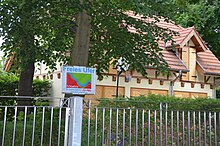Neubabelsberg
Neubabelsberg is after the founding of the German Empire created and since 1939 to Potsdam belonging villa colony . It is located in the eastern Potsdam, southwest of Berlin local situation Kohlhasenbrück (district Wannsee ) and extends from the S- Bahnhof Griebnitzsee along the Griebnitzsee up to the former imperial garden Park Babelsberg with the therein Babelsberg Palace .
The villa colony was created in the area of the municipality of Klein Glienicke in the Teltow district , which was renamed Neubabelsberg in 1925 . The community of Neubabelsberg was incorporated into the city of Nowawes on April 1, 1938 , which was also renamed Babelsberg . The city of Babelsberg was incorporated into the city of Potsdam on April 1, 1939.
history

The Societät Neubabelsberg of the architects Wilhelm Böckmann and Hermann Ende created a new settlement area in Neubabelsberg from 1871 for wealthy Potsdamer and Berliners, later also for film actors like Marika Rökk , Sybille Schmitz , Lilian Harvey , Willy Fritsch or Brigitte Horney , which brought the proximity to the neighboring film studios in Babelsberg appreciated. There are also former guest houses of the UFA and DEFA , which during the filming hosted Heinz Rühmann , Marlene Dietrich and Hans Albers , as well as Jean Gabin , Gérard Philipe and many others. The architects Ludwig Mies van der Rohe , Hermann Muthesius and Alfred Grenander built several villas in Neubabelsberg, the architecture office Peter Behrens with its employees Walter Gropius , Adolf Meyer and Le Corbusier planned here. From 1898 to 1920, the Central Office for Scientific and Technical Investigations , a research facility of the German armaments industry, was located in Neubabelsberg .
In the time of National Socialism , many Jewish Neubabelsbergers were forced to emigrate . The houses that became vacant through emigration were either sold below their value or used by National Socialist organizations. Thus, for example, from the Villa of the exiled UFA director Alfred Zeisler the home of Marika Rokk and Georg Jacoby , in the villa of a Jewish banker Jakob Goldschmidt one was Reich leaders school set. In January 1943 the Gestapo deported the last Neubabelsberg Jews from a sick and old people's home to a concentration camp . Only Otto Liebknecht , Karl Liebknecht's brother , and his Jewish wife were spared deportation until the end of the war in 1945. In the villa of the von Tresckow family in 1944, the group around Henning von Tresckow and Claus Schenk Graf von Stauffenberg assembled the bomb for the assassination attempt on Adolf Hitler , before heading towards Wolfschanze .
During the Potsdam Conference in Cecilienhof Palace in 1945, negotiators Winston Churchill , Josef Stalin and Harry Truman lived in Neubabelsberg . The villas in which the three statesmen lived at the time are still named after them today. The Churchill Villa was built by the Bauhaus architect Mies van der Rohe immediately before the First World War and is inhabited by Hasso Plattner . The Friedrich Naumann Foundation is housed in the Truman Villa . The order for the atomic bombs to be dropped on Nagasaki was also given in it at the time. The Stalin Villa was also built shortly before the First World War by the Swedish architect Alfred Grenander.
Today's S-Bahn station was built in 1862 to develop the Neubabelsberg settlement. It was originally called Neubabelsberg , was renamed Babelsberg-Ufastadt in 1938 and has been called Griebnitzsee since 1949 .
With the construction of the Berlin Wall in 1961, Neubabelsberg was cut off from the Griebnitzsee by border installations on the bank. The Griebnitzsee station became a heavily shielded border station .
After DEFA was founded, some villas in Neubabelsberg were used by the "Konrad Wolf" University of Film and Television - from 1954 to 2000 - before it was given its new building in the media city of Babelsberg next to the film studios .
The ownership structure of some of the villas in Neubabelsberg is currently still unclear. In the cases that have been resolved, retransfers often took place, which resulted in the houses being sold and those living there having to move away. Some buildings are therefore empty and the associated gardens have run wild. The rights of passage on the banks of the Griebnitzsee (“Uferweg”), for which a citizens' initiative has organized, are particularly controversial .
literature
- Ingo Krüger : Stein pieces Neubabelsberg walks. Pharus, Berlin 2009, ISBN 386514165X .
- Paul Sigel, Silke Dähmlow, Frank Seehausen, Lucas Elmenhorst: Architectural Guide Potsdam. Reimer, Berlin 2006, ISBN 3-496-01325-7 .
- Ulrich Damerau: From the Stern hunting lodge via Neubabelsberg to the Glienicke Bridge. Books on Demand, Norderstedt 2008, ISBN 978-3-8370-6047-8 .
- Jana Galinowski: Country houses and villas in Potsdam. Volume 1: Neubabelsberg and Griebnitzsee. Aschenbeck, Delmenhorst 2004, ISBN 978-3-932292-46-0 .
- Christa and Johannes Jankowiak: Babelsberg - A district of Potsdam. 2nd Edition. Stapp, Berlin 1999, ISBN 3-87776-933-0 .
- Jörg Limberg: Potsdam. The villa and country house colony Neubabelsberg , Brandenburgische Denkmalpflege, 1993, issue 2 ( online , PDF)
- Support group Bohemian village Nowawes and Neuendorf (ed.): Neuendorf - Nowawes - Babelsberg • Stations of a district. 3. Edition. Geiger, Horb am Neckar 2008, ISBN 978-3-89570-653-0 .
Web links
Individual evidence
- ↑ Lieselott Enders , Margot Beck: Historical local dictionary for Brandenburg . Teltow district. tape IV . Klaus-D. Becker, Potsdam 2011, ISBN 978-3-941919-81-5 , Klein Glienicke, p. 85 ( digitized from Google Books [accessed April 4, 2016]).
Coordinates: 52 ° 24 ' N , 13 ° 7' E

